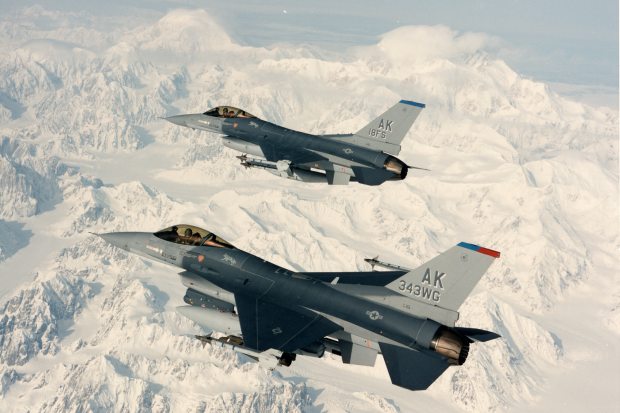Moving F-16 squadron to Anchorage, Alaska could shutter elementary school, mayor says

A proposed move of nearly two dozen F-16 fighter jets from the Fairbanks area to Southcentral could force an Anchorage elementary school to shut its doors. Anchorage Mayor Dan Sullivan said noise from the jets may force the closure and relocation of Mountain View Elementary School, in northeast Anchorage.
The F-16s, used in Alaska to portray enemy aircraft in training, are loud, single-engine jet fighters, considerably louder than the stealthy and modern F-22s already stationed in Anchorage. The F-16s often take off with full-afterburners and the sound can be deafening. Depending on how close you are, it can range from 90 decibles (about the sound of a passing motorcycle) to 200 decibles (the sound of a Saturn V Rocket — the most powerful rocket engine ever built by NASA.)
Eielson Air Force Base, where the F-16s are based now, is 20 miles south of Fairbanks and surrounded by sparsely inhabited terrain. Joint Base Elmendorf-Richardson (JBER) – where the Air Force proposes to move the fighters – borders Anchorage, Alaska’s largest city of nearly 300,000 people. Noise from the base is easily heard in several East Anchorage neighborhoods, including Government Hill and Mountain View.
“Looking at the Air Force’s noise data on the move, we may have to close or relocated Mountain View Elementary because of the noise from the F-16’s,” said Sullivan.
And that’s just one of the concerns Sullivan has with the proposed move.
‘Unanswered questions’
The Anchorage mayor returned from the Interior on Wednesday after meeting with Fairbanks area officials. On Tuesday, people in Anchorage commented on the plan and concerns over noise and other problems associated with the move of the jets and the 1,500 people who work on them.
Meetings about a draft environmental impact statement continued Wednesday night in Fairbanks, with another planned for Thursday in North Pole, the town closest to Eielson.
Sullivan was in Fairbanks to join a chorus of Interior Alaska mayors asking the Air Force for more information about the proposed move.
“There are a lot of unanswered questions,” said Sullivan, who added that he is neither for nor against the idea, only frustrated at what he called a lack of planning by the Air Force.
“They have yet to come up with a strategic plan for moving the jets and personnel. They seem to be saying, ‘We will move them first, and then come up with a plan later,’” Sullivan said.
$200 million savings?
The Air Force wants to move the 21 jets, plus all the Air Force personnel and civilian employees who support the planes, to Joint Base Elmendorf-Richardson, bordering Anchorage. Air Force estimates show the plan would save the Department of Defense about $200 million over five years. But few Alaska politicians believe the math.
Both Sens. Lisa Murkowski and Mark Begich oppose it and claim the Air Force is underestimating the impact the move would have on both the Interior and Anchorage.
The Air Force said it wants to keep Eielson open for training missions, a so-called, “warm base” plan.
“You can’t keep a warm base in a cold place,” said Murkowski.
The move would leave only a handful of Air Force personnel in Eielson. Housing would have to be torn down, facilities shuttered — and that will cost money too.
“If they move the people from Eielson to Anchorage, they will have to demolish a bunch of property in Eielson. I don’t think the Air Force has considered that,” said Sullivan.
The people who are transferred to Anchorage would need new places to live, and even the Air Force has said there are not enough suitable units in Anchorage to hold them all — meaning 150 families would be scrambling to find a place to live at their new duty station.
‘Devastating’ impact
The impact of the move on the Fairbanks economy could be enormous, too. Eielson Air Force Base and its support staff account for about 10 percent of the area’s economy, according to some estimates.
“It would be devastating,” said Fairbanks North Star Borough Mayor Luke Hopkins.
Hopkins testified Wednesday night in Fairbanks to ensure his concerns would be on the record – requiring a response from the Air Force.
“We have asked time and again for answers to our concerns, and the Air Force has just side-stepped the issue,” Hopkins said.
It is not the first time the Air Force has tried to downsize Eielson Air Force Base. In 2005, the base was set to be closed, part of the Base Realignment and Closure Committee’s (BRACC) work. But an outright revolt over the idea — including thousands of local residents packing a local stadium, led by former Air Force Gen. Pat Gambell, now the president of the University of Alaska — managed to convince the Air Force to change its mind.
Many in the Interior believe the proposed move of the F-16 squadron is the Air Force’s way of avoiding the BRACC rebuff.
“(The Air Force) is not even bothering to go through the back door to avoid the BRACC problem,” said Mayor Hopkins. “They are going in straight through the side door.”
The Air Force is expected to release its final strategic plan about the planned move in November.
Contact Sean Doogan at sean(at)alaskadispatch.com



